Two of the country’s most infamous human rights violators were sentenced to life in prison today, as verdicts in the historic ESMA megatrial were handed down.
Outside the court, human rights activists and organisations cheered as the verdicts were handed down in what has become the country's longest human rights trial. In total, 29 people were handed life sentences, 19 received sentences of between eight and 25 years, and six were acquitted.
Hundreds of people outside the courtroom celebrated as sentences were read. Some held a large poster with photos of the 54 defendants with a letter "P'' for "perpetua," referring to life sentences, scribbled over the men's faces. Others held banners about the disappeared that read: "Tell us where they are."
Oral Federal Criminal Court No. 5, at the Comodoro Py Courthouse in the nation’s capital, sentenced a number of individuals to life in prison including Jorge “El Tigre” Acosta and Alfredo Astiz, a naval officer who has been nicknamed ‘The Angel of Death.’
The duo are two of the most well-known repressors from the country’s last military dictatorship and both were found guilty of crimes committed at the ex-ESMA Navy Mechanics School - the biggest clandestine torture centre under the country’s last military dictatorship (1976-1983).
In total fifty-four people, including two civilians, are standing trial for crimes against 789 victims, many of which have been proven in separate trials, that saw close to 5,000 of the former dictatorship’s political enemies tortured and disappeared.
Astiz sat motionless Wednesday as a judge read the charges against him. They included kidnapping, torture, homicide and the appropriation of minors. His nickname came from his cherubic looks and for his work delivering dissidents to the military junta as an undercover agent. He previously was convicted of kidnapping, torturing and murdering two French nuns and a journalist and was already serving a life sentence.
He has remain unrepentant. "Human rights groups want persecution and vengeance," he said during the trial. "I'll never say I'm sorry."
In the past, Astiz had accused former president Cristina Fernández de Kirchner of promoting unjust and illegitimate prosecutions for her own political gain. Her late husband and predecessor as president, Néstor Kirchner, supported the trials after the National Congress and Supreme Court removed legislative amnesties that had protected junta veterans.
Two military pilots were also handed life in prison for their role in the infamous “death flights,” in which people were tortured, drugged, transferred and killed by being thrown from planes into the Rio de la Plata or the sea. The ESMA megatrial is the first to deliver rulings on participants in the secret programme. Pilots Mario Daniel Arrú and Alejandro Domingo D’Agostino were given life sentences for their role in throwing 12 people to their deaths in December 1977.
Victims of the flights include the French nuns Alice Domon and Leonie Duquet, who were abducted and killed along with founders of the Mothers of the Plaza de Mayo in December 1977. The remains of Duquet and three of the Mothers of the Plaza de Mayo were found on Argentina's Atlantic coast and buried in a nearby cemetery. Domon's remains were never recovered.
"In Argentina's history, the death flights will always be regarded as an incomparable monstrosity," said human rights activist Eduardo Jozami. "It's key that this vision held by most Argentines has been ratified with this sentence."
Among other crimes, Astiz and Acosto were accused of the 1977 disappearance of Swedish citizen Dagmar Hagelin, who was 17 years old.
This is the third trial for human rights violations committed at ESMA, and some 800 witnesses have given court testimony. This megatrial began on November 28, 2012 and has lasted more than five years, the longest human rights trial in national history. Since the process began, 11 of the accused have died, and three were deemed too ill to face trial.
Only a fraction of an estimated 5,000 opponents of the regime, which ruled from 1976-1983, survived being sent to the infamous site. Victims included Montoneros guerrillas, labour union leaders, students, leftist sympathisers and in some instance, their relatives and friends.
Human rights groups estimate about 30,000 people were killed or disappeared during the 1976-1983 dictatorship.
"The reparation of victims and of society is only possible if the state complies with its obligations to investigate, sanction and reconstruct history," said the Centre for Legal and Social Studies (CELS), which was part of the legal team representing plaintiffs in the case.
The reading of the Wednesday verdict lasted for almost four hours in a packed courtroom in which the defendants were separated by glass from the public, which included victims and relatives of victims.
Outside, people including dozens of human rights activists followed the proceedings on a giant screen.
"It will be like what happened with the Nazis, wherever they go we will go looking for them," survivors, children and mothers of the disappeared and others intoned.
"The huge number of cases and accused gives a sense of the repression," survivor Carlos Loza said.
"We're living a historic moment," said Taty Almeida, an activist with the Mothers of Plaza de Mayo, a group that has campaigned to find people disappeared by the junta.
"More than ever, we're going to keep demanding justice," she said.
The former ESMA Naval Mechanics School, a leafy former military campus, is now home to a museum dedicated to preserving evidence of crimes against humanity. The grounds also used to house a maternity ward where pregnant detainees were held until they gave birth and then were made to "disappear."
THOSE GIVEN LIFE SENTENCES IN PRISON
Jorge Eduardo Acosta, Randolfo Agusti Scacchi, Mario Daniel Arru, Alfredo Astiz, Juan Antonio Azic, Ricardo Miguel Cavallo, Rodolfo Cionchi, Daniel Néstor Cuomo, Alejandro Domingo D'Agostino, Hugo Enrique Damario, Francisco Di Paola, Adolfo Miguel Donda, Miguel Ángel García Velasco, Pablo Eduardo García Velasco, Alberto E. González, Orlando González, Rogelio José Martínez Pizarro, Luis Ambrosio Navarro, Antonio Pernías, Claudio Orlando Pittana, Francisco Lucio Rioja, Juan Carlos Rolón, Néstor Omar Savio, Hugo Sifredi, Carlos Guillermo Suárez Mason.
OTHER SENTENCES
Juan Arturo Alomar (13 years in jail), Juan Alemann (13 years), Paulino Oscar Altamira (8 years y 6 meses), Daniel Humberto Baucero (10 years), Carlos Octavio Capdevilla (15 years), Miguel Enrique Clements (8 years), Juan de Dios Daer (8 years), Carlos Eduardo Daviou (12 years), Jorge Manuel Díaz Smith (12 years), Juan Carlos Fotea (25 years), Rubén Oscar Franco (20 years), Jorge Luis Magnacco (14 years), Víctor Roberto Olivera (14 years), Eduardo Aroldo Otero (17 years), Mario Pablo Palet (8 years), Guillermo Pazos (16 years), Antonio Rosario Pereyra (10 years), Héctor Francisco Polchi (11 years), Miguel Ángel Alberto Rodríguez (8 years).
- TIMES












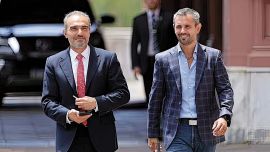








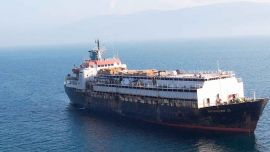
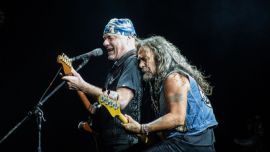
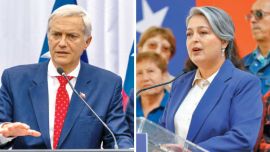

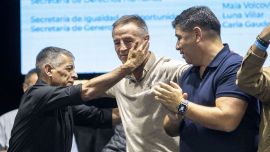
Comments